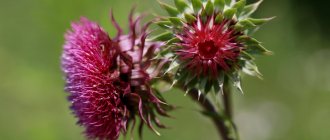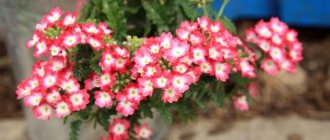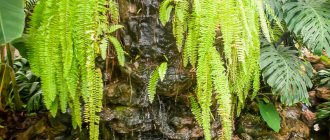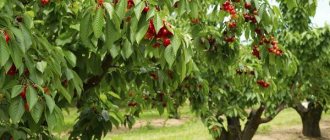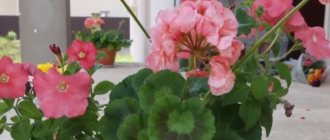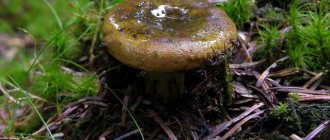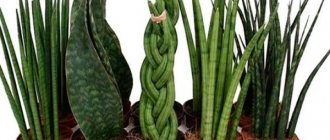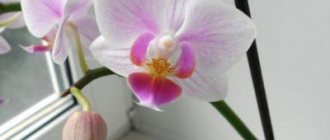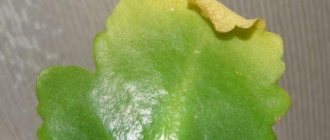Botanical characteristics and history of appearance
An annual herbaceous plant from the Verbenaceae family . The flowers are small (1.5 - 2 cm in diameter), each with 5 petals with thorns. Together they form inflorescences consisting of 30-50 small flowers.
On one hanging shoot, up to 30 inflorescences can bloom simultaneously, emitting a pleasant aroma.
Their colors are varied:
blue;- red;
- purple;
- yellow;
- salmon;
- pink.
Flowers can be plain or with light spots in the middle . The shape of the dark green leaves is elongated oval or serrated; they are quite dense and pubescent. The fruit is light brown or greenish in color and resembles a nut, which subsequently breaks into 4 parts.
The plant’s homeland is South and North America, from where it successfully migrated to Europe, the Mediterranean countries, Central Asia and the Far East. This popularity is due to the unpretentiousness of the plant, its long flowering, wide palette of colors, rapid growth and spectacular appearance. In warm countries, this flower does not know a state of rest, but in our latitudes it is grown as an annual plant.
Features of the view
The main feature of the plant is flowing stems , the length of which reaches 60 cm. The main purpose is to grow in hanging flowerpots, pots, hanging boxes and baskets for the purpose of landscaping balconies, terraces, gazebos.
Another feature of this plant:
- the flower is food for caterpillars and butterflies;
- is actively used in medicine (improves appetite, activates brain activity, treats abscesses);
- in cooking (used to give pickled cucumbers a special aroma);
- on the farm (verbena is an excellent honey plant).
Description and photos of varieties
Ampelous verbena is an ornamental plant that is a relatively recent result of selection, but already has about 250 varieties. The most popular of them include:
Imagination
A variety of ampelous verbena, the creeping shoots of which reach 50 cm in length . Purple-lilac inflorescences are similar in shape to a ball. This variety is characterized by rapid vegetative growth, so it is often used not only for vertical gardening, but also as a ground cover crop.
The variety is characterized by increased resistance to adverse weather conditions. Marked with the Flerselect quality mark.
Red Imperial Tiara (Red Imperial Crown)
The hanging plant attracts attention with its brightness and richness of color . Scarlet lush inflorescences look impressive against the background of bluish-green carved foliage. Flowering is long and abundant. It is unpretentious in care, has increased resistance to frost (up to -3C) and drought.
Lenai Candy Kay
Verbena of the ampelous series, stem length - 45 cm. The flowers are large, multi-colored: on a white background there is a red-crimson core in the shape of a star. Has a subtle berry aroma.
Moon River
An ampel variety of verbena, the length of the shoots is 45 cm. The color of the inflorescences is lavender. Actively used for decorative purposes .
Peach and Cream
An ampelous plant characterized by a combination of apricot, cream, yellow and orange flowers in one inflorescence.
This variety was awarded the Flerselect gold medal in 1992.
We invite you to watch a video about the verbena variety Peach and Cream:
Mammut
One of the oldest varieties. Its distinctive feature: elongated inflorescences are located on half-meter shoots .
Tropic
Ampelous verbena of bright red color.
Temari
Hanging branched shoots of an ampelous appearance bear lilac-violet, purple inflorescences.
The variety is resistant to fungal infections.
Tapien
The plant is characterized by creeping branched shoots , long and intense flowering, unpretentiousness, and sufficient resistance to adverse environmental factors.
The Snow Queen
A mixture of ampelous verbena, numbering up to five colors of inflorescences.
How to care for ampelous verbena
Abundant flowering of verbena is a worthy reward for proper care of it. Despite the fact that this plant is quite unpretentious, it is important to know that:
- if the soil in which the flower grows has too much nitrogen and is too wet, numerous shoots will begin to form, and inflorescences, on the contrary, will stop forming;
- verbena , as a rule, tolerates drought well, but its endurance should not be tested - the soil should always be moistened;
- the plant must be fed every 10-14 days with complex fertilizers.
Conditions and care
- Lighting . Ampelous verbena loves well-lit places where it will have enough light and warmth. Otherwise, you may not be able to wait for flowering - all the plants’ energy will be spent on growing green mass.
- Air and temperature . This plant is resistant to adverse external factors, including fluctuations in air temperature: it tolerates drought well and can withstand frosts down to -3C.
- The soil . Ampelous verbena does not make any special demands on the soil. But it is better if the soil is loose and light. This effect can be achieved by adding sand to ordinary garden soil.
- Watering .
The flower loves moderate but systematic watering. The best option is to prevent the top layer of soil from drying out, especially during extreme heat. It is enough to water the plant three times a week. In order to retain moisture in the soil, you can mulch the bush with sawdust, moss or rotted leaves. With the onset of autumn, watering usually stops. - Feeding .
Like all plants, ampel varieties of verbena need additional nutrition. During the period of active growth of deciduous mass, the plant should be fed with fertilizers with a high percentage of nitrogen content, and during the flowering period, complex fertilizers will be needed, the components of which will be potassium, phosphorus, and manganese. It is possible to use organic matter, especially for verbena planted in open ground. It will be enough to fertilize the soil with humus (5 kg per 1 sq.m.) before planting. Fertilizers are usually applied 3–4 times per season.
Verbena in Christianity
Verbena is considered a sacred plant in Christianity. It was called "cross grass" because these flowers grew on the ground covered with the blood of Christ. Legend has it that verbena was found on Mount Golgotha. It was applied to the wounds of the Savior crucified on the Cross to stop the bleeding. The verbena plant was harvested during special phases of the moon. Before picking a plant, believers were required to be baptized.
Planting and transplanting
The optimal time for planting is May-June . When planting verbena in a flowerpot, you should proceed from its volume:
2–3 shoots should be planted in a five-liter container;
- for a seven-liter plant, the number of seedlings can be increased to 4 - 5.
When planting in open ground, ampelous begonia is planted at a density of 40 plants per 1 sq.m, making space between seedlings of 25 - 30 cm.
The best way to replant a plant is the plant transshipment method . The essence of this method is to move the plant from one place to another along with a lump of earth, which avoids injury to the root system.
You can learn more about the basic rules for planting and caring for verbena here.
Growing seedlings
The best time to plant verbena seeds is March or April, as the sprouts need a lot of sunlight. The process of germinating seedlings is quite simple.
the seeds a little and scatter them on the ground; perlite or regular sand is perfect, but you should not cover the seeds with soil on top.
Place the container on a windowsill that receives plenty of sunlight and cover with glass or plastic wrap.
The optimal temperature for seed germination is approximately 25 °C, so it is recommended to place the tray next to the radiator for 2-3 days, and then move it to a cooler place.
After about a week, the first shoots . Now you need to carefully monitor the condition of the soil in which the seedlings are located. Sudden changes in humidity can provoke damage to seedlings by the “black leg”, leading to their inevitable death.
Approximately 2 weeks after picking the seedlings, it is recommended to fertilize the plants using complex fertilizers.
If the time for sowing has been missed or you simply don’t want to do it, it won’t be difficult to purchase verbena seedlings.
Reproduction
The main methods of propagation of ampelous verbena are cuttings and propagation by seeds.
Read more about growing and propagating verbena from seeds and cuttings in this article.
Cuttings
The mother plant, removed from the soil along with a clod of earth, must be wintered indoors, where the average temperature during the cold season fluctuates between +5 - +10C.
- In February - March, the apical part with 5 - 6 leaves is cut off from the shoots.
- There must be a distance of 1 cm between the lower node on the cutting and the cut point.
- The lower leaves should be cut from the cutting, its tip treated with a root formation stimulator and buried in loose soil (sand and peat in a 1:1 ratio) to the bottom pair of cut leaves.
- The top of the container is covered with glass or polyethylene to create a greenhouse effect: the “greenhouse” is systematically opened slightly for ventilation.
- The soil is moistened as the top layer dries.
The rooting process lasts about 20 - 30 days, after which the young shoots can be planted in a permanent place.
We invite you to watch a video about cuttings of ampelous verbena:
Seeds
This method of propagation is usually carried out 2 months before the hanging begonia is planted in a permanent place (February - March). Verbena seeds have good germination rates .
To germinate them, you need to fill a shallow container with sand (perlite) and moisten it.
- Place the seeds on the surface without deepening or crushing them with substrate.
- Afterwards, the container is covered with glass or plastic film in order to create conditions close to greenhouse conditions, and it is placed in a warm place (the temperature should not be lower than +25C).
- The shelter should be systematically opened slightly and the container ventilated in order to prevent putrefactive processes.
- When the first shoots appear (after 20-30 days), the temperature can be lowered by 5 degrees, remove the glass, and provide the seedlings with good lighting (you can use a phytolamp).
- Then each plant should be picked (after the appearance of 2 true leaves) into separate containers.
- After releasing 5 - 6 (7 - 8 cm) leaves, pinching is done (the top of each shoot is broken off to ensure future good branching of the bush).
Verbena after flowering
How and when to collect seeds
Verbena, grown in our climate as an annual, is destroyed in the fall and the area is dug up. But if you want to collect seeds from your own plants, do this when most of the capsules dry out and turn brown. Place the cut inflorescence with capsules on paper or fabric and let it dry, turning it over from time to time so that it does not become moldy, then extract the seeds from the nuts, pour them into a paper bag or box and label them.
But keep in mind that the seeds you collect will not retain the varietal characteristics of their parents, so it is better to purchase planting material in the store in the spring - thank God, there is no shortage of verbena seeds.
Overwintering verbena
There is only one type of verbena that can be grown as a perennial in our climate - straight verbena (Verbena stricta), and if you are the happy owner of this rare plant in cultivation, then before the onset of winter, cut the stems of the plant to the level of the ground and cover the remains of the bush with spruce branches in case the winter is too frosty or snowless.
In the photo: Delicate pink verbena
Diseases and growing problems
Ampelous verbena is an unpretentious plant. It will not cause much trouble for the gardener. The only disease that a plant will definitely be exposed to in case of excessive watering and high air temperature is powdery mildew.
Damage to rot, black leg, and spotting is also possible, but these cases are uncommon. Special medications sold in specialized stores (Fundazol, Saprol) can help cope with such problems.
Ampelous verbena is susceptible to attacks by aphids . This pest can be combated using purchased products, or using traditional methods: 300-400g of laundry soap is grated and mixed with 10 liters of water. This solution should be used to wash the leaves of the plant affected by aphids.
A bright cascade of multi-colored flowers of ampelous verbena will decorate any garden plot or balcony. In addition, the unpretentiousness of the plant and its resistance to diseases make ampelous verbena one of the most popular flowers in the world.
Verbena flowers are amazing with their dim beauty! Already in the Middle Ages, verbena became a panacea for many diseases. Our experts have prepared a series of articles about the medicinal properties, contraindications and use of the plant in folk medicine, as well as about other types and varieties, including hybrid, medicinal and finely dissected.
Verbena - growing, planting, care
Verbena is a flower that has been grown by more than one generation of amateur gardeners. In addition to the fact that this is a beautiful plant, it is also useful (Verbena officinalis), and is quite easy to grow. In nature, there are about 120 species of this plant. Among them there are both annual and perennial species, there are also semi-shrubs and creeping ones, which we readily grow as hanging plants. Verbena is often called “Pigeon Grass” among the people. I have never found a clear explanation for this name. But verbena is credited with a great many different magical properties - from kindling love to the ability to open locks and constipation.
The most popular species among gardeners is considered to be “ Hybrid Verbena ”. It is the one that can most often be found in flower beds and flower beds.
